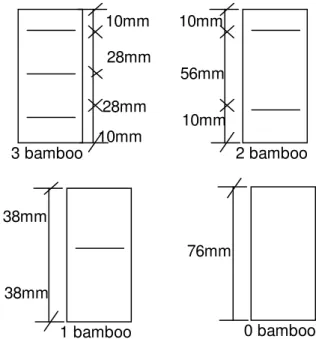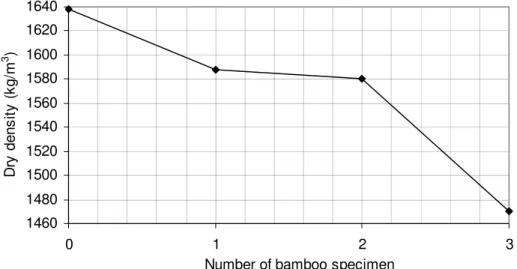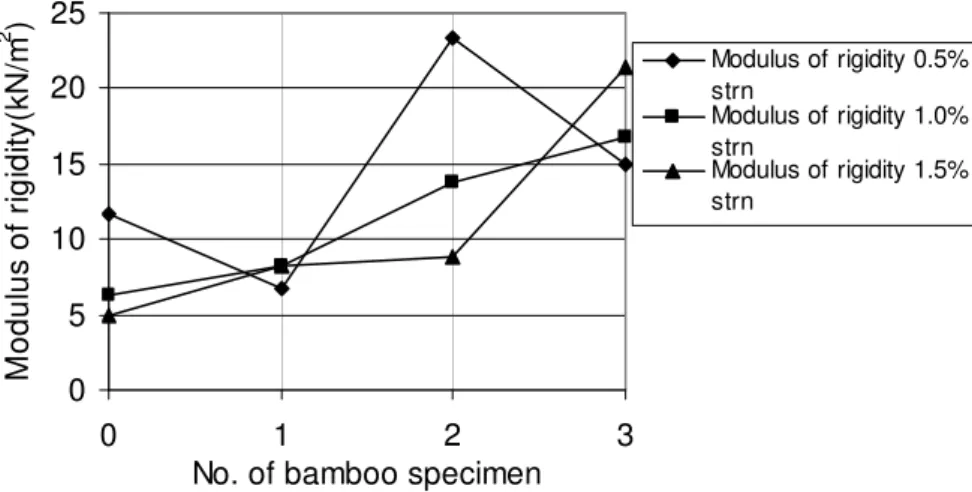http://ljs.academicdirect.org
Bamboo as Soil Reinforcement: A Laboratory Trial
Alhaji Mohammed MUSTAPHA
Civil Engineering Department, Federal University of Technology, Minna, Nigeria.
E-mail: mustpelemi@yahoo.com
Abstract
A lateritic soil classified as A-6 under AASHTO soil classification system
was reinforced with 0, 1, 2 and 3 bamboo specimens at laboratory trial level to
evaluate its unconfined compressive strength (UCS) and modulus of rigidity.
The soil specimens were molded in cylindrical form of 38mm diameter and
76mm height while the bamboo specimens were trimmed in to circular plates
of 34mm diameter and 3mm thickness. The trial soil specimens are: soil
specimen without bamboo specimen (0 bamboo), soil specimen with one
bamboo specimen in the center (1 bamboo), soil specimen with one bamboo
specimen on top and one at the bottom (2 bamboos) and soil specimen with
one bamboo specimen on top, center and bottom (3 bamboos). Though, the
dry density of the molded soil specimen decreased from 1.638Mg/m3 at 0 bamboo to 1.470Mg/m2 at 3 bamboos, the UCS increased from 226KN/m2 at 0 bamboo to 621KN/m2 at 3 bamboos. Also, for each of the 3 percentage strains (0.5, 1.0 and 1.5%) considered, the modulus of rigidity increased with
bamboo specimens.
Keywords
Since when [1], first developed the reinforcing technic to a stage where it can be
economically applied to large soil structure, majority of the authors; [2], [3], [4], [5], and [6]
concentrated on retaining structures. According to [7], reinforced earth can be defined as a
construction material composed primarily of soil whose performance has been improved by
the introduction of small quantities of other materials in the form of solid plates or fibers or
fibrous membranes to resist tensile forces and interact with soil through friction and/or
adhesion.
However, all the above mentioned materials employed as reinforcement in soils are
presently expensive and would require a cheaper and abundant material with similar strength
and durability to that of steel reinforcement. Bamboo, a perennial grass, belonging to the class
monocotyledoneae, exists abundantly in tropical, subtropical and temperate zones of the
world and have been mentioned by [8] as a potential material for reinforced earth. According
to [9], more than 10 million tones of bamboo are produced annually with most coming from
Asia. Studies have shown that bamboo posses high tensile and compressive strength and have
been used as reinforcement in concrete especially when the specie is properly seasoned and
have lasted more than 3 years [10], [11] and [12].
The aim of this work therefore is to carry out a laboratory trial on the use of cheap and
abundant bamboo as a material for soil reinforcement.
Materials
Soil
The soil used in this study was a lateritic soil collected along Sarkin pawa-Kaduna
road using the method of disturbed sampling. According to [13], the soil in this area belongs
to Ferruginous tropical soil derived from acid igneous and metamorphic rocks. The soil was
Government, Niger State, Nigeria. This area lies between longitude 6°E and 7°E and latitude
90N and 100N. The area is drained by several rivers which are tributaries of River Niger. The rainfall in this area varies from 1000 to 1500mm per annum.
The bamboo specimens were cutted and trimmed into a circular plate of 34mm
diameter and 3mm thickness. The smooth surface of the bamboo specimens was roughened to
increase the friction between the specimen and the soil. The sketch of a bamboo specimen is
shown in figure 1: below:
34 mm
Figure 1. Bamboo specimen
Methodology
Tests including liquid limit, plastic limit, washed sieve, analysis, hydrometer analysis
and specific gravity were performed on the air dried soil. Compaction test was also carried out
on the soil to determine its optimum moisture content (OMC) and maximum dry density
(MDD). All these tests were conducted according to procedures highlighted in [14] with
modifications where necessary.
Unconfined compressive strength (UCS) specimens were molded in a triaxial
compressive strength mould of diameter 38mm and height of 76mm. The specimens were
prepared in four forms as shown in figure 2 below. These are soil specimen without bamboo
specimen (0 bamboo), soil specimen with one bamboo specimen in the centre (1 bamboo),
soil specimen with bamboo specimen on top and bottom (2 bamboos) and soil specimen with
Figure 2. Soil specimens with 0, 1, 2 and 3 bamboo specimens
In all these tests, the bamboo specimen was placed horizontally in the layers. The
same compaction effort was applied to all the four forms of soil-bamboo specimen system.
During compaction, the bulk density and molding moisture contents were determined. The
UCS test was then conducted on the four different soil-bamboo specimens and its failure
stresses as well as the stress-strain relationship of each of the specimen systems determined.
Results and Discussion
The results of the index properties and grain size analysis are shown below in table 1
and figure 3 respectively.
Table 1. Index properties of the soil
Description SG LL(%) PL(%) PI(%) MDD(KG/M3) OMC(%) AASHTO
Values 2.58 30 25 5 1880 15.5 A-6
76mm
0 bamboo 38mm
1 bamboo 38mm
10mm
2 bamboo 56mm
10mm 10mm
3 bamboo
28mm
28mm
0 10 20 30 40 50 60 70 80 90 100 0.001 0.01 0.1 1 10
Sieve size (mm)
P er c en tage pa s s in g( % )
Figure 3. Particle size distribution for the sample
The results of the grain size distribution and other index properties above showed that
the soil classified under A-6 sub-group according to AASHTO soil classification system.
Dry Densities
The maximum dry density (MDD) and optimum moisture content (OMC) of the soil
compacted at West African compaction energy level (WAS) is 1.88Mg/m3 and 15.5% respectively. The variation of the molded dry densities for UCS specimens is shown in figure
4 below. The value of the molded dry densities decreased from 1.638Mg/m3 at 0 bamboo specimens to 1.470Mg/m3 at 3 bamboo specimens. This is probably due to low specific gravity bamboo that substitutes a high specific gravity soil sample.
1460 1480 1500 1520 1540 1560 1580 1600 1620 1640
0 1 2 3
Number of bamboo specimen
D ry d ens it y (k g/ m 3 )
The UCS increased with increase in the number of bamboo specimens as shown in
figure 5 below. The value increased from 226KN/m2 at 0 bamboos to 621kN/m2 at 3 bamboo specimens. This is probably due to the friction between the soil sample and the rough surface
of the bamboo specimen.
200 250 300 350 400 450 500 550 600 650
0 0.5 1 1.5 2 2.5 3
Number of bamboo specimens
UCS
(
k
N
/m
2 )
Figure 5. Variation of UCS with the number of bamboo specimens
Modulus of Rigidity
The stress - strain relationship for each of the molded specimens and variation of the
modulus of rigidity at 0.5, 1.0 and 1.5% with the number of bamboo specimens are shown on
figures 6 and 7 respectively, below. The trend of modulus of rigidity with percentage strain is
erratic in nature. While modulus of rigidity of some soil-bamboo specimen decreases with
increase in percentage strain, others increase in like order. At 0 bamboo specimen, the value
decreased from 11,666KN/m2 at 0.5% to 5000KN/m2 at 1.5% while at 2 bamboo specimen, the value decreased from 23,448KN/m2 at 0.5% to 8,928KN/m2 at 1.5%. However, the trend for 1 and 3 bamboo specimens are different. At 1 bamboo specimen, the modulus of rigidity
100 200 300 400 500 600 700
0 0.5 1 1.5 2 2.5 3 3.5 4
Strain (%) St re ss (kN /m 2 ) Stress/0 bamboo Stress/1 bamboo Stress/2 bamboo Stress/3 bamboo
Figure 6. Stress-strain relationship for specimens at 0, 1, 2, and 3 bamboo specimens
0 5 10 15 20 25
0 1 2 3
No. of bamboo specimen
M odul us of r ig id it y (k N /m 2 )
Modulus of rigidity 0.5% strn
Modulus of rigidity 1.0% strn
Modulus of rigidity 1.5% strn
Figure 7. Variation of modulus of rigidity with No. of Bamboo specimen
This trend is in agreement with [7] and is due to friction between the soil and the
rough surface of bamboo specimen.
Conclusions
In conclusion, it was observed that while the dry density of the molded specimens
decreased with the number of bamboo specimens, the UCS and the modulus of rigidity
increased with increase in the number of bamboo specimens. While the dry density of the
modulus of rigidity also increased with increase in the number of bamboo specimens for each
of the percentage strains considered. At 1.5%, the modulus of rigidity increased from
5000KN/m2 at 0 bamboos to 21,428kN/m2 at 3 bamboo specimens.
Recommended Area of Further Study
i. Employing statistical analysis to determine an empirical relationship between bamboo
specimens, the spacing of the bamboo specimens and UCS values.
ii. The use of bituminous material on the smooth surface of bamboo specimen to mobilize
shear strength.
iii. A prototype study of the potentials of bamboo as soil reinforcement.
References
1. Vidal H., The principle of Reinforced Earth, Highway Research Record, 282, pp. 1-6,
1969.
2. Al-Hussaini M. and Perry E.B, Field experiment of reinforced earth wall, Journal of the
Geotechnical Engineering Division, ASCE, 104(GT3), paper 13596, pp. 307-321, 1978.
3. Holtz R.D, Recent Developments in Reinforced Earth, Proc. 7th Scandinavian Geotechnical Meeting, Copenhagen, published by polyteknisic Forlag, pp. 281-291, 1975.
4. Holtz R.D., and Broms B.B, Walls Reinforced by Fabric. Results of Model Tests, Proc. of
the International Conference on the use of Fabrics in Geotechnics Paris,1, pp. 113-118,
1977.
5. Lee K.L, Adams B. D and Vagneron J.J., Reinforced Earth Retaining Walls, Journal of
Soil Mechanics and Foundation Division, ASCE, 99, SM 10 proc., paper 10068, pp.
745-764, 1973.
6. Schlosser F and Long N.T, Recent Results in French Research on Reinforced Earth,
Journal of the construction division, ASCE, 100 (paper 10800), pp. 223-237, 1974.
8. Punmia B.C, Ashok K.J and Arun K.J., Soil Mechanics and Foundations, 16th ed. Laxmi Publication Ltd, pp. 887-888, 2005.
9. Sharma Y.M.L., Bamboo in Asia-pacific Region, Proc. of a Workshop, Singapore, pp.
99-120, 1980.
10.Brink F.E and Rush P.J., Bamboo Reinforced Concrete Construction, U.S Naval Civil
Engineering Lab, California, pp. 17, 1980.
11.De Simone D., Substitution for Steel in Reinforced Concrete, Royal Engineers Journal, 54,
pp. 237-244, 1939.
12.Hamid A., Structural Aspect of Bamboo Reinforced Soil Cement. Thesis No. 523. Asian
Institute of Technology, Bangkok, pp. 105, 1973.
13.Areola O., Soils. In: Nigeria in maps. Edited by Barbou. K.M. Hodder and Stoughton,
London, 1982.
14.BS 1377, Method of Testing Soil for Civil engineering purposes, British Standard Institute



